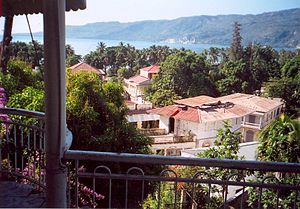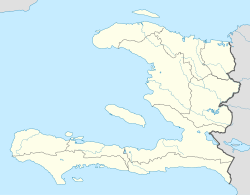Jacmel
|
Jacmel Jakmèl |
|
|---|---|
| Commune | |

View of Jacmel
|
|
| Location in Haiti | |
| Coordinates: 18°14′7″N 72°32′12″W / 18.23528°N 72.53667°WCoordinates: 18°14′7″N 72°32′12″W / 18.23528°N 72.53667°W | |
| Country |
|
| Department | Sud-Est |
| Arrondissement | Jacmel |
| Demonym | Jacmelien(ne) |
| Founded by Spain | 1504 |
| French settlement | 1698 |
| Founded by | Nicolás de Ovando |
| Government | |
| • Mayor | Edwin Zenny |
| Population (2003) | |
| • Commune | 26,077 |
| • Metro | 40,000 |
| Time zone | Eastern (UTC-5) |
| • Summer (DST) | Eastern (UTC-4) |
Jacmel, (Haitian Creole: Jakmèl; Spanish: Yáquimo) is a commune in southern Haiti founded by the Spanish in 1504 and repopulated by the French in 1698. It is the capital of the department of Sud-Est and has an estimated population of 40,000, while the commune of Jacmel had a population of 137,966 at the 2003 Census. The town's name is derived from its indigenous Taíno name of Yaquimel. In 1925, Jacmel was dubbed as the "City of Light," becoming the first in the Caribbean to have electricity.
The city has well-preserved historical French colonial architecture that dates back from the early nineteenth century and has little changed. The town has been tentatively accepted as a World Heritage site and UNESCO reports that it has sustained damage in the 2010 Haiti earthquake.
The town was founded by Dominicans ("Compagnie de Saint-Domingue") in 1698 as the capital of the southeastern part of the French colony Saint-Domingue. The area now called Jacmel was Taíno territory, part of the Xaragua chiefdom ruled by cacique Bohechio. With the arrival of the French, and the later establishment of the town, the French renamed Yaquimel as Jacmel.
The city was developed to boost sugar production and trade, but soon it evolved into a coffee trading centre. In 1896 it suffered a major fire that destroyed most of the buildings in the city. The city was rebuilt, often using prefabricated cast-iron pillars and balconies shipped from France. Many ornate mansions of wealthy coffee merchants from this time have been preserved up to this day without much change and the whole central part of the city has changed little over the last 100 years.
The mansions of Jacmel, with their cast-iron pillars and balconies, would later influence the homes in much of New Orleans. Today, many of these homes are now artisan shops that sell vibrant handicrafts, papier-mâché masks, and carved-wood animal figures. In recent years, efforts have been made to revitalize the once flourishing cigar and coffee industries. The town is a popular tourist destination in Haiti due to its relative tranquility and distance from the political turmoil that plagues Port-au-Prince.
...
Wikipedia

